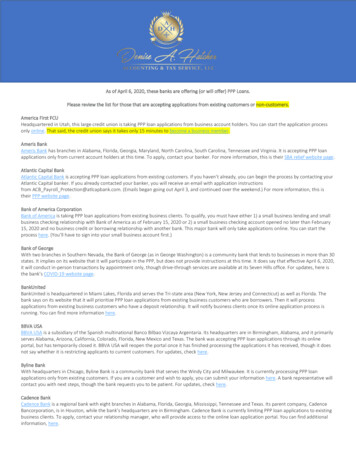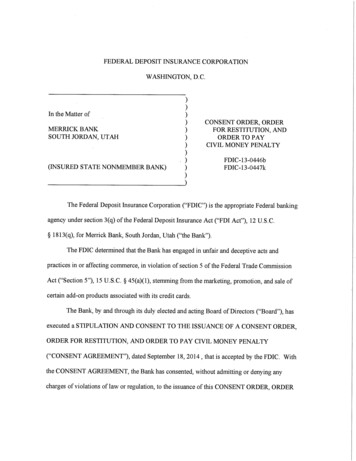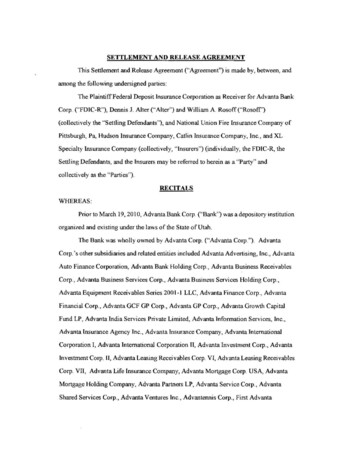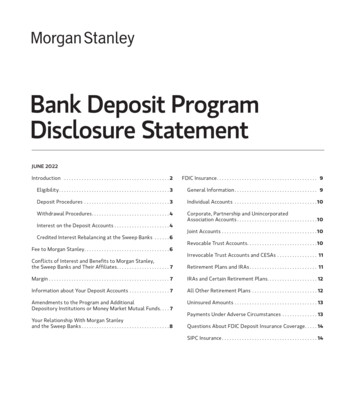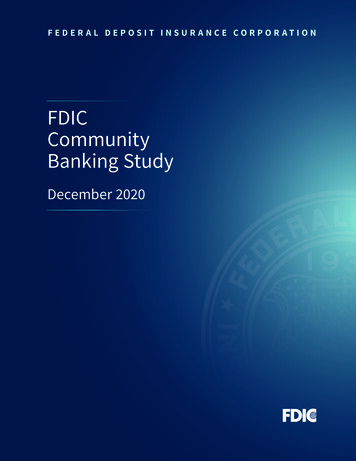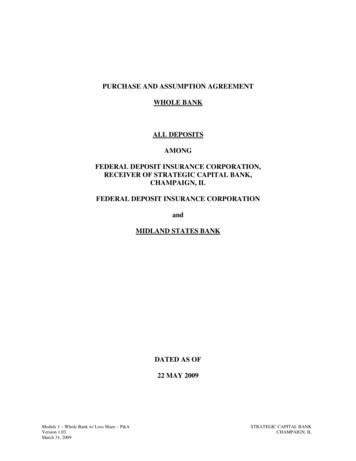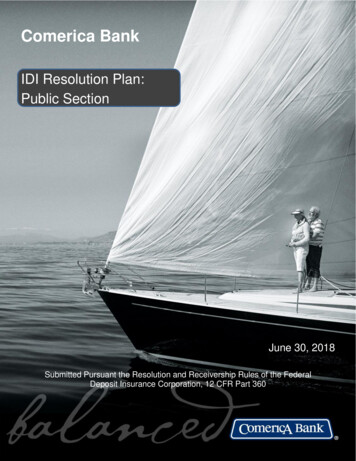
Transcription
Comerica BankIDI Resolution Plan:Public SectionJune 30, 2018Submitted Pursuant the Resolution and Receivership Rules of the FederalDeposit Insurance Corporation, 12 CFR Part 360
Comerica Bank 2013-2018. All rights reserved.Comerica Bank and Comerica Bank & Trust, National Association are each a Member of the FederalDeposit Insurance CorporationEqual Opportunity Lender
Public SectionIDI Resolution PlanSection A: Public Section
Public SectionThis Page is Intentionally Left Blank
Public SectionPart A:Public Section and PublicSummary of Plan
Public SectionThe Public Section of this IDI Resolution Plan is required to be produced in a form that can bedisseminated to the public via the Federal Deposit Insurance Corporation’s website.A. Public Section and Public Summary of the IDI Resolution PlanTable of ContentsIntroductory Remarks . A-iii1. Summary of the Plan and Strategy . A-12. The Comerica Enterprise and Comerica Bank. A-2History . A-2Comerica Bank and Comerica Incorporated Legal Structure . A-2Major Business Segments and Business Lines . A-33. Material Entities. A-34. Board of Directors and Key Management Officers of Comerica Bank . A-35. Core Elements of the Plan. A-4Core Business Lines. A-4Figure 5-1 Description of Core Business Lines . A-4Critical Services . A-56. Payment, Clearing, and Settlement Systems. A-57. Trading, Derivatives, and Hedges . A-6Overview . A-6Balance Sheet Hedging . A-6Global Capital Markets . A-6Booking Practices . A-7Material Hedges . A-7Hedging Strategies . A-78. Description of Foreign Operations . A-89. Management Information Systems, Facilities and Systems . A-8Disaster Recovery and Backup Plans . A-9Shared Facilities and Systems . A-9Facilities . A-9Systems. A-10Capabilities of Systems to Collect Information . A-1010. Applicable Resolution Regime Overview . A-10A-i P a g e
Public Section11. Summary Description of Resolution Plan . A-10Resolution Strategies . A-10Multiple Acquirer Strategy Considerations . A-11Viability . A-11Timing. A-11Benefits . A-11Access to Deposits . A-12Protection of Comerica Bank . A-12Payment, Clearing, and Settlement Service . A-1212. Corporate Governance of the Comerica Enterprise and Resolution PlanningGovernance . A-12Figure 12-1 Comerica Bank’s Plan Governance Structure . A-1313. Supervisory and Regulatory Information. A-14Figure 13-1 Primary Regulatory Authorities . A-14Figure 13-2 Secondary Regulatory Authorities . A-14Figure 13-3 Foreign Regulatory Authorities . A-1414. How to Find More Information Regarding Comerica Bank . A-1515. Forward Looking Statements. A-15Selected Financial Information . A-17Figure SF-1 Comerica Bank and Subsidiaries Consolidating Balance Sheet . A-17A-ii P a g e
Public SectionIntroductory RemarksIn response to concerns about financial institutions deemed “too-big-to-fail,” Congressincluded Section 165 in the Dodd-Frank Wall Street Reform and Consumer Protection Act. Inpart, Section 165 added a new element to the management of systemic bank failure risk in theUnited States. That element is the resolution planning requirement for the largest banks andfinancial services firms operating within the United States.Relevant regulations promulgated by the Board of Governors of the Federal ReserveSystem (“FRB”) and the Federal Deposit Insurance Corporation (“FDIC”) required bank holdingcompanies with 50 billion or more in total consolidated assets to periodically submit a plan to theFRB and the FDIC for their “rapid and orderly” resolution in the event of material financial distressor failure. The FDIC adopted a rule under the Federal Deposit Insurance Act (“FDI Act”) requiringeach insured depository institution with 50 billion or more in total consolidated assets toperiodically submit to the FDIC a plan for the institution’s resolution in the event of its failure. Theresolution plan should enable the FDIC, as receiver, to resolve the institution under the FDI Actin an orderly and timely manner, with the least cost to the FDIC’s Deposit Insurance Fund.For the Comerica enterprise, two resolution plans are required: the “Tailored ResolutionPlan” in the case of Comerica Incorporated and the “IDI Resolution Plan” in the case of ComericaBank (no other affiliate of the Comerica enterprise is required to prepare a resolution plan).As detailed in this IDI Resolution Plan, in the highly unlikely event of Comerica Bank failing,its resolution would occur without the need for external financial support of the United Statesgovernment or the U.S. taxpayer for continued funding. Moreover, under this Plan, there is norisk that the failure of Comerica Bank would have an adverse impact on the financial system ofthe United States. A separate resolution plan was last submitted for Comerica Incorporated in2017.Both the Board of Directors of Comerica Incorporated and Comerica Bank have approvedthe IDI Plan prior to its submission to the agencies.A-iii P a g e
Public SectionPart 1:Public Summary of the Plan andOther Information
Public Section1. Summary of the Plan and StrategyThis IDI Resolution Plan (the “Plan”) sets forth the resolution strategy and informationabout Comerica Bank and its subsidiaries as required under the FDIC’s resolution regulations(“IDI Rule”) promulgated under the Federal Deposit Insurance Act (“FDI Act”). Comerica Bankis a covered insured depository institution (“CIDI”) with total consolidated assets in excess of 50billion and is therefore required to submit a plan for resolution pursuant to the FDI Act.This Plan sets out how Comerica Bank could be resolved under the FDI Act in an orderlyand timely manner that ensures that depositors receive access to their insured deposits withinone business day of Comerica Bank’s failure, maximizes the net present value return from thesale or disposition of its assets, and minimizes the amount of any loss realized by the DepositInsurance Fund (“DIF”) and Comerica Bank’s creditors. A resolution of Comerica Bank under thePlan would not require the use of any extraordinary government support or funds from UnitedStates taxpayers and would substantially mitigate the risk that the failure of Comerica Bank wouldhave a serious adverse effect on financial stability in the United States. Furthermore, the Planwould be identical under the Baseline, Adverse, and Severely Adverse scenarios provided to theParent by the Board of Governors of the Federal Reserve System (“FRB”) pursuant to 12 U.S.C.5365(i)(1)(B) for the purposes of the Capital Plan Review. The Plan does not reflect ComericaBank’s actual risks. Instead, the Plan’s hypothetical failure scenario is designed only for thepurpose of developing the required resolution plan.Comerica Incorporated (the “Parent”) and its consolidated subsidiaries are referred to inthis Plan, collectively, as the “Comerica Enterprise.” As of December 31, 2017, Comerica Bank,an insured depository institution with 71.5 billion in total consolidated assets, is the dominantsubsidiary of the Comerica Enterprise. Comerica Bank is the Parent’s principal insured depositoryinstitution1 and the only insured depository institution in the Comerica Enterprise required to file aresolution plan with the FDIC. Comerica Bank operates across five primary geographic markets:Texas, Arizona, California, Florida, and Michigan (collectively, the “Market States”).Comerica Bank’s conservative risk appetite has resulted in an operating model andorganizational structure that is streamlined and straightforward. Specifically:Comerica Bank serves clients and markets primarily in the United States;Comerica Bank has a limited number of subsidiaries, the majority of which are engagedin traditional banking activities; andComerica Bank has a large and stable deposit base to fund its operations, reducingreliance on wholesale market funding.Based on Comerica Bank’s size and the continued lack of systemically importantoperations, the failure of Comerica Bank would not have a material impact on the stability of theU.S. financial system. As measured by assets, loans, or deposits, Comerica Bank represents farless than 1% of total FDIC-insured institutions. Prompt action by the FDIC, using its authorityunder the FDI Act and the information provided in this Plan, would lead to a rapid and orderlyresolution of Comerica Bank.This Plan presents three strategies for the resolution of Comerica Bank in an FDICreceivership. The FDIC’s Guidance for Covered Insured Depository Institution Resolution PlanSubmissions requires this Plan to present two strategies under which Comerica Bank can be1Comerica Incorporated has one additional insured depository institution, Comerica Bank & Trust,National Association (“CB&T”), which operates as a limited-purpose trust bank with assets of approximately 54 million as of December 31, 2017.A-1 P a g e
Public Sectionresolved in the highly unlikely event of its failure: the Multiple Acquirer Strategy and the LiquidationStrategy. Comerica Bank’s preferred resolution strategy is the Multiple Acquirer Strategy. Underthe Multiple Acquirer Strategy, upon Comerica Bank’s failure and the FDIC’s appointment asreceiver, Comerica Bank would segment its businesses and would be sold separately to thirdparty purchasers or via an Initial Public Offering (“IPO”) of a bridge bank established by the FDIC.This Plan also presents a third strategy, the Friday Evening Sale Strategy, which Comerica Bankbelieves to be a reasonable resolution strategy.2. The Comerica Enterprise and Comerica BankHistoryThe Comerica Enterprise traces its roots back to the formation of the Detroit Savings FundInstitute in Michigan in 1849. Since that time, Comerica Bank and its Parent grew with Detroitand the Michigan economy along with the auto industry, followed snowbird Michiganders toFlorida and Texas, and first expanded to California as a result of auto dealer financing. In 2007,Comerica moved its headquarters to Dallas, Texas, and since then has been advancing itsstrategy to diversify its customer base and reach into key high-growth markets.The longevity of the Comerica Enterprise is a testament to its strong relationship bankingfocus, conservative principles, and people—the approximately 8,200 colleagues who serve asambassadors in the community. Comerica Bank has received a “Satisfactory” rating from theFRB for its Community Reinvestment Act activities.Comerica Bank and Comerica Incorporated Legal StructureAs of March 30, 2018, the Comerica Enterprise comprises a total of 36 legal entities, plusfive insurance agencies, two insured depository institutions (Comerica Bank and CB&T), oneleasing company, and one broker-dealer.Comerica Bank had approximately 71.5 billion in total consolidated assets as ofDecember 31, 2017. It is a commercial bank with a traditional bank-centric structure and almostall of its activities are domestic. Comerica Bank provides commercial banking, consumer banking,and wealth management services through its banking center network and other distributionchannels. A limited number of products and services are provided by the subsidiaries of theParent, with the vast majority of activity occurring solely within Comerica Bank. As a result ofComerica Bank’s domestic presence and its focus on traditional banking activities, ComericaBank has a straight-forward legal entity structure.The Parent serves as a financial holding company for Comerica Bank and is incorporatedunder the laws of the State of Delaware and headquartered in Dallas, Texas. Although the Parentis the ultimate holding company of the several Comerica legal entities, the Parent has nooperational activities. In a business-as-usual context, the Parent serves as a vehicle foraccessing the capital markets, receives dividends from its consolidated subsidiaries, andfacilitates the movement of liquidity and funding throughout the Comerica Enterprise for strategicor other purposes.The Parent conducts banking operations through Comerica Bank, which represents 99%of total consolidated assets of the Comerica Enterprise. Apart from investment in subsidiaries,the Parent’s remaining assets are largely comprised of cash. The Parent owns 100% of theissued and outstanding common shares of Comerica Bank. Comerica Bank is a Texas statechartered commercial bank that is a member of the Federal Reserve System. As of December31, 2017, Comerica Bank operated 589 ATMs, employed approximately 8,200 associates, andoperated 437 banking centers in five states: Texas, Arizona, California, Florida, and Michigan,as well as select business lines operating in Canada, the Caribbean, and Mexico and other loanA-2 P a g e
Public Sectionproduction offices, representative offices, and other non-branch facilities located throughout theUnited States. Comerica Bank has a predominantly regional footprint with a high concentrationof its business in Texas, California, and Michigan.Major Business Segments and Business LinesThe Comerica Enterprise provides customers with the resources and products expectedof a large bank and the personalized service of a smaller, community bank. It relies on arelationship banking strategy built on skill and experience as a differentiating strength. Comericadoes not concentrate on simply one account or one transaction, but on developing acomprehensive relationship that encompasses multiple products, services, and skills. Theobjective of the relationship banking strategy is to grow and maintain long-term relationships withits customers across all of its business divisions.Comerica Bank has strategically aligned its operations into three major businesssegments: the Business Bank, Retail Bank, and Wealth Management, serving businesses,consumers, high-net-worth individuals, and others within its geographic footprint.3. Material EntitiesUnder the IDI Rule, a “material entity” is a company that is significant to the activities of aCritical Service2 or Core Business Line3 (“Material Entity” or “Material Entities”). In determiningwhich entities of the Comerica Enterprise are Material Entities under the IDI Rule, several factorswere considered:Percent of total assets, revenue, and net income;Business purpose and mapping to Critical Services and Core Business Lines;Legal or regulatory requirements;Impact on customer retention or growth; andRelative size of employee base.After considering these factors, it was determined that only two Material Entities exist forthe Comerica Enterprise: the Parent and Comerica Bank.4The following parts of this summary provide a high-level overview of the Plan and itsstrategies. Unless otherwise indicated, all numbers and financial data are as of December 31,2017.4. Board of Directors and Key Management Officers of Comerica BankThe members of the Board of Directors of Comerica Bank are:2Under the IDI Rule, a “critical service” means a service or operation of the CIDI, such as servicing,information technology support and operations, human resources and personnel that are necessary tocontinue the day-to-day operations of the CIDI (“Critical Service”).3For purposes of this Plan and as specified in the IDI Rule, a core business line is a business line,including associated operations, services, functions, and support that, in Comerica Bank’s view, uponfailure would result in a material loss of revenue, profit, or franchise value (“Core Business Line”).4Under the IDI Rule, only those insured depository institutions that meet the definition of a MaterialEntity have to file a CIDI resolution plan. Although the Parent has two insured depository institutions in itsaffiliate group (i.e., Comerica Bank and CB&T), Comerica Bank is the only Material Entity under the IDIRule.A-3 P a g e
Public Section Ralph W. Babb, Jr., Chairman and Chief Executive Officer Curtis C. Farmer, President, Comerica Incorporated and Comerica Bank Muneera S. Carr, Executive Vice President and Chief Financial Officer Peter W. Guilfoile, Executive Vice President and Chief Credit Officer Michael H. Michalak, Executive Vice President and Chief Risk Officer The key management officers of Comerica Bank comprise the Management ExecutiveCommittee (“MEC”). In March 2018, the members of the MEC were: Ralph W. Babb, Jr., Chairman and Chief Executive Officer Curtis C. Farmer, President, Comerica Incorporated and Comerica Bank Muneera S. Carr, Executive Vice President and Chief Financial Officer Peter W. Guilfoile, Executive Vice President and Chief Credit Officer John D. Buchanan, Executive Vice President, Chief Legal Officer and Corporate Secretary Christine M. Moore, Executive Vice President, General Auditor Paul R. Obermeyer, Executive Vice President and Chief Information Officer Megan D. Burkhart, Executive Vice President and Chief Human Resources Officer Michael H. Michalak, Executive Vice President and Chief Risk Officer5. Core Elements of the PlanThe following parts of the Plan lay out Comerica Bank’s Core Business Lines and CriticalServices.Core Business LinesComerica Bank has analyzed its primary lines of business to identify those businessesthat qualify as Core Business Lines and has determined that it has two lines of business that areCore Business Lines.The Core Business Line determination involved a review of products and services offeredby Comerica Bank, a determination at the product and service level of whether products andservices were core or non-core, a mapping of the core products and services to a primary line ofbusiness, an assessment of the relative contributions of all business lines from loan, deposit, andnet income perspectives, and an analysis of the relative values of the business lines. Figure 5-1below describes Comerica Bank’s two Core Business Lines and their respective products andservices.Figure 5-1 Description of Core Business LinesCore Business LinesBusiness BankDescriptionThe Business Bank meets the needs of middle market businesses, multinationalcorporations, and governmental entities by offering various products and services,including commercial loans and lines of credit, deposits, cash management, capital marketproducts, international trade finance, letters of credit, foreign exchange managementservices, and loan syndication services.A-4 P a g e
Public SectionCore Business LinesRetail BankDescriptionThe Retail Bank includes small business banking and personal financial services,consisting of commercial lending, deposit gathering, and other business-banking services.In addition to a full range of financial services provided to small business customers, thisCore Business Line offers a variety of consumer products, including deposit accounts,installment loans, credit cards, home equity lines of credit, and residential mortgage loans.Given Comerica’s relationship-driven strategy, Wealth Management is a strategically imperativebusiness segment for Comerica Bank, but for resolution planning purposes, is not considered aCore Business Line.Critical Service5The Critical Services that Comerica Bank has identified are Human Resources, Finance,Corporate Legal, Audit, Operations, Information Services, Treasury, and Enterprise Risk.6. Payment, Clearing, and Settlement SystemsComerica Bank is a member of a number of payment, clearing, and settlement systemsthat are common to every bank in its size range in the country. It can safely be assumed that anypotential third-party purchasers will also be direct members of each of these systems and woulduse their own pre-existing memberships with the same payment, clearing, and settlementsystems. It is also assumed that a bridge bank established in the Multiple Acquirer Strategy wouldbe able to maintain access to Comerica Bank’s systems. The challenge would come during theRunway Period because the systems might, during that period, ask for additional assurances,collateral, or margin. These reactions would depend upon the rules of the particular system, butit is likely that a system would allow Comerica Bank to continue to access its platform as long asComerica Bank is able to meet the existing and any newly imposed requirements.Comerica Bank has a direct membership with the following payment, clearing, andsettlement systems: Automated Clearing House network – via FedACH and The Clearing House ElectronicPayments Network (EPN) Check Clearing – via FIS Endpoint Exchange, FRB Check Services, The Clearing HouseImage Exchange, and various correspondent/respondent bank relationships Fedwire Funds Service - wire transfer services Fedwire Securities Service – transfer and settlement services for all marketable U.S.Treasury securities Society for Worldwide Interbank Funds Transfer (SWIFT) – messaging service used forinternational payments JP Morgan Access – Global Capital Markets uses JPM’s MORCOM reporting platform to5In addition to identifying Critical Services, Comerica Bank also reviewed its operations to determinewhether it had any critical operations. A critical operation is any service or operation, including associatedservices, functions and support, the failure or discontinuance of which, in the view of the covered companyor as jointly directed by the FRB and the FDIC, would pose a threat to the financial stability of the UnitedStates (“Critical Operations”). After evaluating its operations, services, and functions in terms ofsubstitutability, size, and market share, it was determined by Comerica Bank that it does not provideoperations, services, or functions whose failure or discontinuance would pose a threat to the financialstability of the United States. Accordingly, Comerica Bank does not have any Critical Operations.A-5 P a g e
Public Sectionretrieve reports of activities related to JPM acting as our sole Futures CommissionMerchant (FCM), i.e., servicing agent for Chicago Mercantile Exchange (CME) trades Payment Card Solutions Elan Financial Services – credit card partner that owns the retail card accounts andprovides card access via Visa, Mastercard and American Express networks Mastercard Network – payment processor for Comerica prepaid cards, commercial creditcards and debit cards PULSE Network – Alternate payment processor for Comerica's ATM & Point of Sale debitcards Worldpay (formerly Vantiv) Merchant Card – payment service provider to merchants Visa Network – payment processor for Comerica prepaid cards7. Trading, Derivatives, and HedgesOverviewComerica Bank executes hedging transactions on behalf of customers and hedges its ownbalance sheet. All energy and interest rate derivatives transactions, as well as all material ForeignExchange derivative transactions are ultimately matched with individual offsets and managedwithin policy VaR. In conformance with the Dodd-Frank Act and regulations issued under section619 of that Act (the “Volcker Rule”), Comerica Bank does not engage in proprietary tradingactivity.Located in Dallas, Texas, the Parent’s Treasury Group uses derivatives, as appropriate,to reduce exposure to interest rate risk as well as manage the corporate balance sheet. ComericaBank will typically enter into either cash flow or fair value hedges under the ASC 815 standard tomanage the rate risk. Additionally, there are several swaps between the Parent and ComericaBank that Treasury oversees that are used to transfer risk from the debt transactions.Located in Michigan, Global Capital Markets engages in the offsetting of derivatives tomanage the market risk associated with client derivatives. Comerica Bank hedges the clientderivatives book with matching dealer trades.Balance Sheet HedgingDerivatives are entered into to manage interest rate risk and facilitate asset/liabilitymanagement strategies. Derivative financial instruments that qualify for an ASC 815 hedgingrelationship are classified, based on the exposure being hedged, as either fair value hedges orcash flow hedges. Comerica Bank formally documents all hedging relationships between hedginginstruments and hedged items, as well as its risk management objective and strategy for enteringinto various hedge transactions. Comerica Bank performs monthly assessments to determinewhether the hedging relationship has been highly effective in offsetting changes in fair values orcash flows of hedged items and whether the relationship is expected to continue to be highlyeffective in the future.Global Capital MarketsGlobal Capital Markets (“GCM”) offers financial derivatives to clients of Comerica Bank.This activity is conducted under the supervision of the Asset Liability Management Committee(ALCO) of Comerica Bank.The group is divided between marketing functions and trading. Marketing is responsibleA-6 P a g e
Public Sectionfor working with Comerica Bank’s clients to arrive at hedging strategies that meet their needs.Foreign exchange trading is conducted to manage Comerica Bank’s risk resulting from foreignexchange marketing activity, most of which is accomplished by trading with other banks in thewholesale market.Comerica Bank offsets derivative risk resulting from hedges offered to Comerica Bank’sclients. Foreign exchange rate risk is hedged as a result from trading foreign exchange withComerica Bank’s clients. The types of trades booked include foreign exchange spot, forward,swap and option trades.Booking PracticesRelationship managers of the Business Bank and Retail Bank (e.g., small businesscustomers) contact Comerica Bank’s centralized capital markets area to facilitate customerhedging transactions.All of the Parent’s derivatives are booked at Comerica Bank.For foreign exchange trading, the majority of trades dealing with customers are conductedtelephonically over a recorded line. Once consummated, the trade is keyed on to the SPOTSystem, which is the foreign exchange trading system. The trade immediately updates ComericaBank’s currency position so that the foreign exchange dealer may monitor and hedge positionsreal-time. Once entered, the trade is independently confirmed and settled by GCM Operations,independent of Global Capital Markets. Trades can also be dealt by clients using Comerica eFX,an automated dealing platform hosted by Comerica Bank. Comerica Bank enters into trades withother dealers using a variety of dealing platforms.For derivatives, all trad
Comerica Bank has a large and stable deposit base to fund its operations, reducing reliance on wholesale market funding. Based on Comerica Bank's size and the continued lack of systemically important operations, the failure of Comerica Bank would not have a material impact on the stability of the U.S. financial system.
